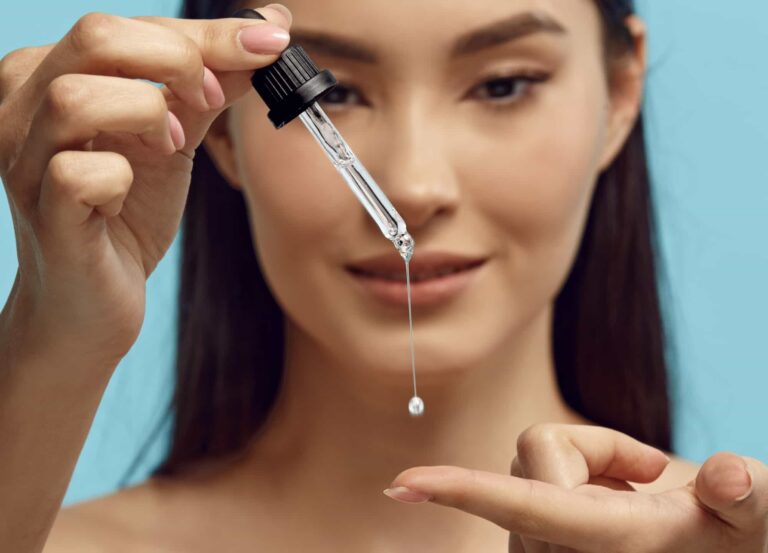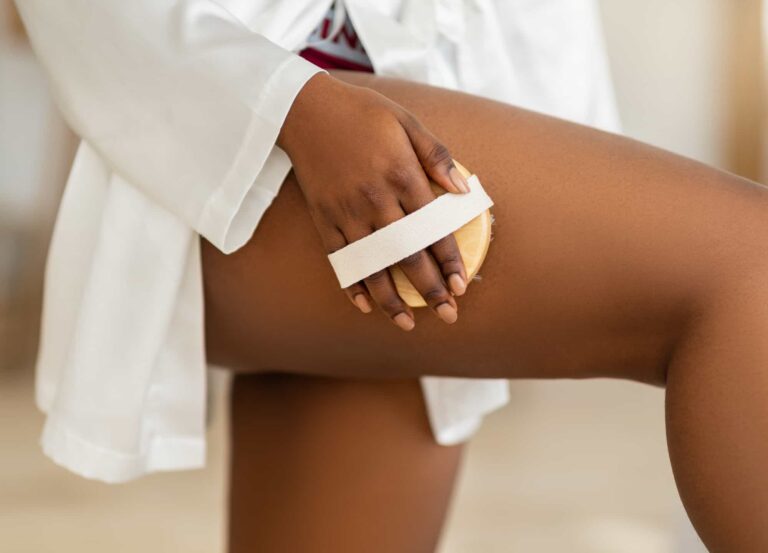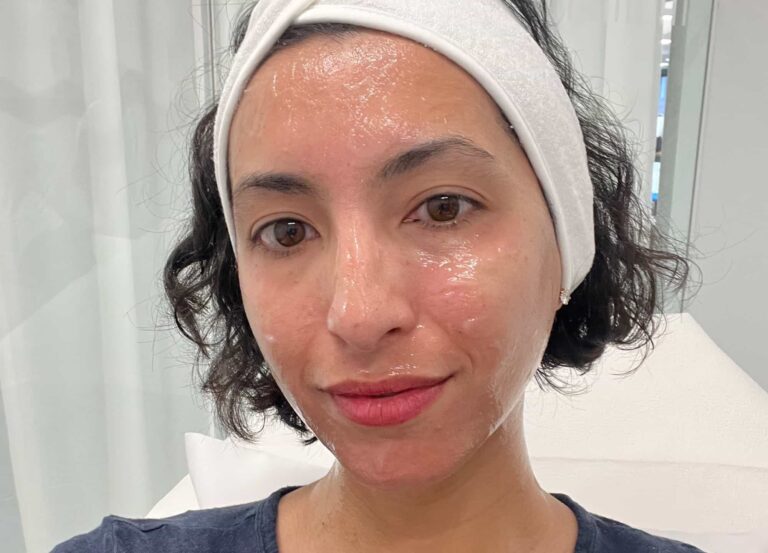Even if you’re well-versed in skin care, to the point where you’d consider yourself fluent, the language of professional aesthetics treatments is totally different—and can be incredibly confusing. There are so many unique offerings at doctors’ offices and medspas that you may not know where to begin, and on top of that, quite a few of them target the same concerns. That’s especially true in the laser category. Phrases like the HALO hybrid laser and words like erbium can be challenging to decipher, and there are dozens of devices that claim comparable results. So how do you figure out which one is best for your needs?
As is the case with any aesthetics procedure, a good provider will work with you, to create a custom laser treatment plan designed to help you reach your specific goals. But ahead of meeting with them, it’s worth doing your homework, to understand what kinds of lasers are out there, what they can treat, and what you should know pre- and post-treatment. Keep reading for your comprehensive guide to laser treatments, including a breakdown of the differences between the ablative, the non-ablative, and the all-encompassing HALO laser.
How do laser treatments work?
“Having lasers in my practice allows me to take my patients’ results to the next level,” says Dr. Marguerite Germain, a board-certified dermatologist in Mount Pleasant, South Carolina. “With customized wavelengths and delivery methods, lasers allow me to specifically target a wide range of skin concerns that address everything from youthful skin in need of a little touch-up to deep sun damage and wrinkles found in my more mature patients.”
While varying lasers target different concerns, they all function using the same premise. “Lasers or laser devices use a range of different energy wavelengths, short and/or long, which equate to the level of penetration into the skin,” explains Dr. Ava Shamban, a board-certified dermatologist in Beverly Hills, California.
The deeper your treatment goes, the more profound your results will be—but there’s a caveat. To achieve those really powerful results, you can generally expect to experience “radical recovery and downtime,” says Dr. Dennis Gross, a board-certified dermatologist in New York City. That said, “laser resurfacing recovery time varies by type of laser and level of intensity as well as number of passes,” explains Dr. Shamban. “Variances are also due to individual patients’ skin condition [and] thickness, age, and personal metabolic healing rate,” she says, adding that, as with snowflakes, no two patients are alike.
What skin-care concerns can laser treatments address?
Dr. Gross states that there are three concern categories with which lasers can help: discoloration caused by red pigment (such as broken capillaries, port wine stains, and rosacea); brown pigment-based discoloration (like postinflammatory hyperpigmentation or PIH, melasma, and dark spots); and collagen-based issues. This latter group includes everything from fine lines and wrinkles to uneven texture and skin laxity. The type of laser treatment you receive will be determined by your skin tone, along with your specific goals and concerns and how aggressively you’re willing to treat them.
What kinds of laser treatments are there?
There are many different types, but they can all be broken down into three major subdivisions: ablative, non-ablative, and hybrid.
Ablative lasers
“The word ‘ablative’ is synonymous with ‘invasive,’” says Dr. Gross. This type of laser is responsible for significant downtime, and most frequently, you’ll see these lasers labeled as erbium or CO2. “Ablative [laser] is the most intense, obliterating the top layers of skin while getting to the deeper layers of dermis to heat, treat, and heal,” says Dr. Shamban. Though “obliterating” sounds like hyperbole, the heat energy of ablative lasers removes the majority of the epidermis and even some of the dermis. “Patients may experience significant social downtime,” agrees Dr. Germain.
“[Ablative lasers best treat] textural issues such as acne scars, deeper fine lines and wrinkles, especially around the mouth and eyes, pore size, and epidermal pigment,” says Dr. Germain. The intensity of the laser’s heat and depth can also act as a wake-up call for the underlying layers of your dermis; once the surface of your skin’s been destroyed, your body engages its natural healing response, which manifests as fibroblast stimulation. Translation: your skin cells start working in overdrive to create new collagen and heal your skin, which improves issues with skin firmness while smoothing deep wrinkles and folds.
However, if your primary skin concern is redness, ablative laser treatment is not for you. “[A complexion with] redness is considered a skin type that is not eligible for invasive laser,” explains Dr. Gross. “It doesn’t work to remove the redness, and it can actually make the redness worse,” he says. This is where non-ablative lasers come into play.
Non-ablative lasers
Knowing that ablative means “invasive,” you can expect non-ablative lasers to be gentler. Generally speaking, “non-ablative lasers target the dermis without injuring the skin’s surface,” explains Dr. Germain. Because the skin’s surface remains intact, you can expect little downtime when being treated with a non-ablative laser. (In fact, most patients experience a maximum of 48 hours of downtime, but zero downtime is also possible.) However, there are pros and cons to these treatments. “These can be a trade-off—no-downtime treatment for efficacy,” remarks Dr. Shamban, who notes that non-ablative laser treatment can require a series of up to six sessions for comprehensive treatment. “Results are both excellent and long-lasting, [but] outcomes are less effective than ablative, which require one [session] for a desired result in most cases.”
Non-ablative lasers can treat all the same concerns as ablative lasers, such as texture concerns like fine lines, wrinkles, acne scarring, and skin laxity, as well as sun damage and brown spots and hyperpigmentation; they’ll just take longer.
Hybrid lasers
The unique category that straddles the line between ablative and non-ablative technology boasts only one device: A next-generation hybrid fractional laser known as HALO. (Fractional lasers target only a “fraction” of the skin at a time.) “The HALO hybrid fractional laser combines ablative and non-ablative wavelengths, delivered to the same microscopic treatment zone, to maximize clinical results and minimize downtime,” explains Dr. Germain. “HALO is safe and effective while providing an enhanced patient experience.”
The “next-generation” aspect refers to the improvement in technology; laser treatments have evolved significantly in past decades to help both the patient and their provider achieve the results they’re craving. “HALO is a great example of that,” says Dr. Germain. “The treatment is able to help patients achieve their desired results without the downtime of traditional ablative lasers.”
Case in point: HALO’s ablative and non-ablative settings are completely customizable. Dr. Germain notes that the ablative setting can be used to “precisely vaporize [epidermal] tissue in a controlled manner, to address textural issues and pore size,” while the non-ablative setting targets the dermis, making it ideal for addressing deeper sun damage and pigment concerns while stimulating collagen production. Because it combines both powerful and gentler technology, patients can see results in fewer sessions than they’d need from a traditional non-ablative laser—one to two, according to Dr. Germain. “Patients notice the HALO glow almost immediately, with continued improvement over time,” she adds. “Patients appreciate the corrective results they experience without the downtime of traditional ablative lasers.”
It’s not just patients who enjoy this experience and downtime. “Providers appreciate the safety profile associated with HALO,” says Dr. Germain. “They feel comfortable knowing their patients can easily manage their recovery at home with basic cleansers, moisturizers, and sunscreen and without any occlusive topicals or vinegar soaks needed.” Easily managed recovery means a better, healthier-looking outcome. This means less work for your provider in the long run—and ultimately, more money saved for you.
I want to try a laser treatment, but I have a deep complexion—what does that mean for me?
Those with melanin-rich skin need to proceed with caution, warns Dr. Shamban. “If not used correctly, lasers pose a greater risk for dark skin,” she says. Dr. Gross agrees, warning that ablative laser treatment becomes riskier, the higher you get up the Fitzpatrick scale. “The higher Fitzpatrick numbers are ineligible for ablative lasers,” he says. “As their skin baselines produce more melanin in general, they have an exceedingly high risk of either stimulating more hyperpigmentation or becoming patchy, having more areas of darker skin in the areas that were lasered.”
Typically speaking, non-ablative lasers are the best option for deep skin tones, as they can be carefully customized to best treat these delicate complexions without damaging the surface. That said, due to HALO’s highly customizable nature, it can be used to treat patients across the entire spectrum of the Fitzpatrick scale, to gently and effectively address all skin goals. “The biggest concern is postinflammatory hyperpigmentation, which can be temporary,” says Dr. Germain. “It is important that you choose a trusted physician.” This is true of any laser treatment; don’t be afraid to ask for before and after images, to ensure you’re in good hands.
What can I expect before and after a laser treatment?
Before treatment
To ensure the best possible outcome from any laser appointment, your skin should be as healthy and balanced as possible in anticipation of your treatment. It’s essential to discontinue use of active skin-care ingredients, particularly topical exfoliators like alpha hydroxy and beta hydroxy acids (AHAs and BHAs), including prescription-strength retinoids, as they can make you more reactive to light. In the case of ablative lasers, skip these treatments for about a week pre-appointment; you can cut that window down to three days if you’re getting HALO or a non-ablative treatment.
For the same reason, the use of photosensitizing medications should also be limited in the days leading up to your appointment. (Work with your doctors to come up with the best course of action for you.) You should also talk to your doctors ahead of your treatment if you’re prone to cold sores. Some lasers can trigger an outbreak; your provider may want to prescribe you a course of antiviral medication.
Another way to ensure better results is to fully avoid sun exposure—and even self-tanner—for several weeks ahead of your laser appointment. Skin that has recently been tanned, even artificially, can trick the device and can cause results that are contrary to your skin goals. “The skin’s machinery to produce [melanin] is ‘preprogrammed’ and stays that way,” explains Dr. Gross. In the case of ablative lasers in particular, he notes that the tanner you are, the deeper your complexion is, or if you’re prone to producing discoloration, laser treatment is much more likely to lead to postinflammatory hyperpigmentation.
After treatment
The more controlled damage a laser incurs, the more downtime you can expect as you recover. If you get an ablative laser treatment, prepare yourself for up to a month of healing, potentially even more if your skin is especially sensitive. “As the lasered skin heals, there will be redness, peeling, inflammation, crusting, rough texture, tightness, itching, and even burning,” notes Dr. Shamban, who notes that some of the symptoms can be reminiscent of a really bad sunburn. “[Skin] may also be raw or oozing,” she adds.
Though you may experience several weeks of skin discomfort post-ablative treatment, that doesn’t mean you’ll need to spend all of that time hidden in your bedroom with the lights off. That’s true of any laser session, even with minimal downtime: you can live your life normally, so long as you’re comfortable and attentive to your skin. Just be sure to follow your treatment protocol closely—your provider will give you one after your appointment—to help protect your skin as you heal.
Other things doctors recommend avoiding following post-laser treatment are excessive sweating, exercise (this includes hot yoga, saunas, and beach vacations), and sun exposure. “Wear a wide-brimmed hat or protective clothing for two months post-treatment, to avoid blistering, scarring, hyperpigmentation, and hypopigmentation,” recommends Dr. Germain. After all, you’ve just invested time and money in your skin—so do everything in your power to protect that investment.











